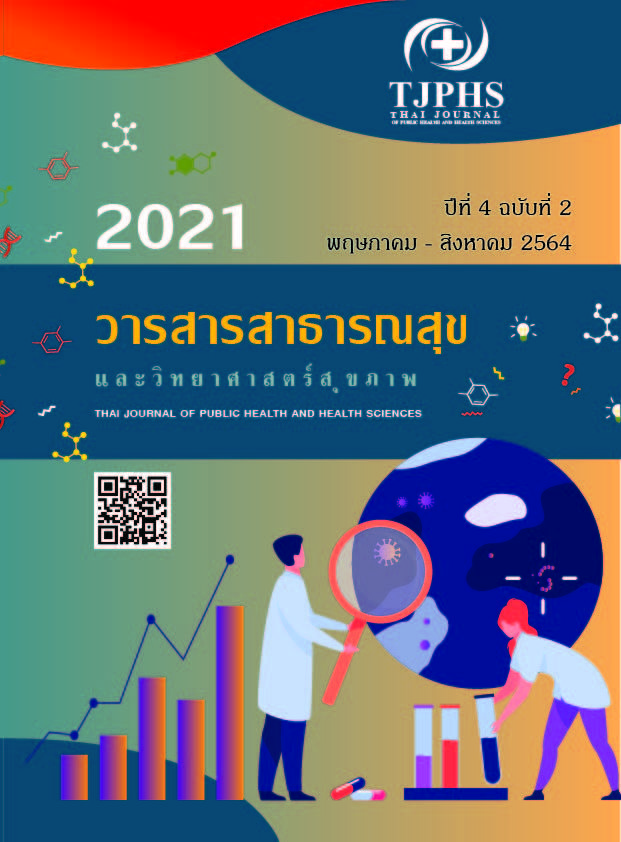การเปลี่ยนแปลงระดับการได้ยินจากการประกอบอาชีพ: การทบทวนวรรณกรรม
คำสำคัญ:
การสูญเสียการได้ยิน, เสียงดัง, อาชีวอนามัยและความปลอดภัยบทคัดย่อ
การเปลี่ยนแปลงระดับการได้ยินจากการประกอบอาชีพส่งผลต่อการเกิดภาวะเสื่อมสมรรถภาพการได้ยิน และโรคประสาทหูเสื่อม มักพบในพนักงานที่สัมผัสเสียงดัง มีสาเหตุจากการขาดพฤติกรรมการปกป้อง ทำงานในพื้นที่ที่มีเสียงดังเกินเป็นระยะเวลานาน จำแนกเป็นการสูญเสียการได้ยินชนิดชั่วคราวและถาวร การทบทวนวรรณกรรมครั้งนี้มีวัตถุประสงค์เพื่อทบทวนปัจจัยที่มีความสัมพันธ์ต่อการเปลี่ยนแปลงระดับการได้ยินจากการประกอบอาชีพ ทำการทบทวนจากบทความวิจัยที่เผยแพร่ตีพิมพ์ในฐานข้อมูลระดับชาติและนานาชาติ นำเสนอผลการทบทวนวรรณกรรมด้วยแผนภูมิต้นไม้ (Forest plot) โดยการกำหนดจากค่าขนาดอิทธิพล (Effect size, Odds ratios [OR]) และช่วงความเชื่อมั่นที่ร้อยละ 95 (95% Confidence interval [95%CI]) จากการทบทวนบทความวิจัยที่เกี่ยวข้องจำแนกออกเป็น 1) ปัจจัยส่วนบุคคล (เพศ อายุ อายุงาน โรคประจำตัว/ปัญหาสุขภาพ) 2) ปัจจัยด้านพฤติกรรมสุขภาพ (การสูบบุหรี่ การใช้อุปกรณ์คุ้มครองความปลอดภัยส่วนบุคคล (PPE) วิธีการใช้อุปกรณ์ การรักษาความสะอาดของอุปกรณ์ การใช้อุปกรณ์ร่วมกับผู้อื่น การรักษาความสะอาดช่องหู (แคะหูด้วยสำลีพันก้าน) และการฟังเพลงเสียงดัง) และ 3) ปัจจัยสิ่งแวดล้อมในการทำงาน (ระยะเวลาในการสัมผัสเสียงดัง ระดับเสี่ยงดังเฉลี่ยในพื้นที่ทำงาน ระยะห่างระหว่างตัวบุคคลและแหล่งกำเนิดเสียง) จากการทบทวนดังกล่าว นักอาชีวอนามัยและความปลอดภัย และแพทย์อาชีวเวชศาสตร์ ควรนำปัจจัยดังกล่าวมาเป็นแนวทางในการวางแผนมาตรการป้องกัน คัดกรองและเฝ้าระวัง เพื่อป้องกันการเกิดการเปลี่ยนแปลงการได้ยินในผู้ป่วยรายใหม่ นอกจากนี้เพื่อลดระดับความรุนแรงของการเปลี่ยนแปลงระดับการได้ยินจากการประกอบอาชีพ ต่อไป
เอกสารอ้างอิง
Kanogwan Arjkaew, Vichai Pruktharathikul, Sunisa Chaiklieng. (2020). Prevalence of Hearing Loss and Noise Exposure among Workers in Air Conditioning and Refrigeration Components Manufacturing, The Public Health Journal of Burapha University. Chon Buri, 1-13. (In Thai)
Bureau of Occupational and Environmental Diseases (BOED) (2018). Report on the situation of disease and health hazards from occupation and environment. Nonthaburi: Department of disease control. (In Thai)
Jirat Jenpanich. (2009). BIOLOGY for high school students.: BOOM COLOR-LINE.
(In Thai)
Theerasit Chernbamrung, Wittaya Pichetwirachai, Sirinthip Chanduaywit, Wanida Inchit, Wantanee Hwanraruen. (2018). The Presence of Notch Shape and Notch Area Observed in Annual Audiometric Test of Employees from 9 Factories in Rayong Province, Thailand, Journal of Public Health, Nakhon Pathom, 33-43. (In Thai)
Theerasit Chernbamrung, Sirinthip Chanduaywit, Wantanee Hwanraruen, Wanida Inchit. (2017). Incidence Comparison of Hearing Threshold Shift before and after Audiometric Baseline Revision for Interpretation Based on NIOSH and OSHA Criteria, The Public Health Journal of Burapha University, Chon Buri, 1-15.
(In Thai)
Theerasit Chernbamrung, Sureerat Theerawanichtrakul, Sirinthip Chanduaywit, Wantanee Hwanraruen, Wanida Inchit. (2017). Prevalence of Hearing Threshold Shift among Chemical Industrial Workers: A Comparison of NIOSH and OSHA Threshold Shift Criteria, Journal of Safety and Health, Nonthaburi, 11- 19. (In Thai)
Pipat Chaempattanakit. (2018). The prevalence rate and risk factors of noise induced hearing loss among occupational noise exposure workers in Pakchong na na Hospital,. District 11 Medical Journal, Surat Thani, 981-991. (In Thai)
Pirawan Chaiyawong, Pornnapa Suggaravetsiri, Sunisa Chaiklieng. (2018). “Factors related to hearing loss among planting farmersin Khon Kaen Province, Department of disease control 17, Khon Kaen, 88-98. (In Thai)
Pornthip Pimda, Naesinee Chaiear, Kwanchanok Yimtae, jiraporn Khiewyoo, Panida Tanawitatananit, Napaporn Krusun. (2016). Incidence of Industrial Employees Having Standard Threshold Shifts; A Study of the Existing Audiograms, Srinakarin Vejsan, Khon Kaen, 287-292. (In Thai)
Puwasit Singhapoom, Srirat Lormphongs, Jitrapun Pusapukdepob. (2013). Combined Effect of Noise Exposure and Smoking to Hearing Loss among Casting Factory Workers, Panthong District, Chon Buri Province,” The Public Health Journal of Burapha University, Chon Buri, 92-100. (In Thai)
Pusit Fuengfoo, Chorjit Rungsiri, Wichote Boonplian, Somthawil Nukit, Suppadit Sanguanuan, Pongthep Harnchumpol, et al. (2013). Noise-induced Hearing Loss in Machinery Laundry of Phramongkutklao Hospital and Occupational Health Management, Royal Thai Army Medical Journal, Bangkok, 161-168. (In Thai)
Summacheeva Foundation. (2018). Guideline for Standardization and Interpretation of Audiometry in the Occupational Health Setting. Chon Buri: Summacheeva Foundation (In Thai)
Ratanaporn Phetprapun, Wamdee Khimuk, Thitiworn Chusong (2015). Evaluation of Noise Levels and Noise-Induced Hearing Loss of Workers at a Stone Milling Factory in Nakornsithammarat Province, Journal of Safety and Health, Nonthaburi, 13-23. (In Thai)
Savitree Chairut, Adul Bundhukul, Penpatra Sripaiboonkij. (2013). Factors related to standard threshold shift in motor compressor workers, Thammasat Medical Journal, Pathum Thani, 59-70. (In Thai)
Apiradee Sriopas, Robert Chapman, Saravudh Sutammasa, and Wattasit Siriwong. (2016). Occupational noise-induced hearing loss in auto part factory workers in welding units in Thailand, J Occup Health, Japan, 55-62.
Aung Kyaw Zaw, Aung Myint Myat, Mya Thandar, Ye Min Htun, Than Htun Aung, Kyaw Min Tun, et al. (2020). Assessment of Noise Exposure and Hearing Loss Among Workers in Textile Mill (Thamine), Myanmar: A Cross-Sectional Study, Safety and Health at Work, Myanmar, 199-206.
Citra Dwi Novastuti, Nyilo Purnami, and Nugraenny Affianti. (2019). Noise Induced Hearing Loss in Ground Handling Workers at Juanda Airport Surabaya Korean,
J Otorhinolaryngol-Head Neck Surg, Korean, 59-63.
Elizabeth A Jacobsen, Marie Haring Sweeney, James A Deddens, Christa L Themann, and David K Wall. (2014). Prevalence of Workers with Shifts in Hearing by Industry: A Comparison of OSHA and NIOSH Hearing Shift Criteria, J Occup Environ Med, American, 1-25.
John Dement, Laura Welch, Knut Ringen, Kim Cranford, and Patricia Quinn. (2018). Hearing loss among older construction workers: Updated analyses, Am J Ind Med, American, 1-10.
Josef Shargorodsky, Sharon G Curhan, Gary C Curhan, and Roland Eavey. (2010). Change in Prevalence of Hearing Loss in US Adolescents, JAMA, American, 772-778.
Linda F Cantley, Deron Galusha, Mark R Cullen, Christine Dixon-Ernst, Peter M Rabinowitz, and Richard L Neitzel. (2015). Association between ambient noise exposure, hearing acuity,and risk of acute occupational injury, Scandinavian Journal of Work and Environment & Health, Finland, 74-83.
Luigi De Maria, Antonio Caputi, Rodolfo Sardone, Enza Sabrina Silvana Cannone, Francesca Mansi, Francesco Birtolo, et al. (2020). Occupational Exposure to Noise and Age-related Hearing Loss in an Elderly Population of Southern Italy, The Open Public Health Journal, Netherlands 69-74.
Mirsaeed Attarchi, Zahra Sadeghi, Farzaneh Dehghan, Mohammad M Sohrabi, and Sadjad Mohammadi. (210). Assessment of Hearing Standard Threshold Shiftbased on Audiometric Findings in Steel Company Workers, Iranian Red Crescent Medical Journal, Iranian 644-649.
Nathan Goldfarb. (1960). An Introduction to Longitudinal Statistical Analysis: The Method of Repeated Observations from a Fixed Sample, Glencoe: Illinois.
P., Nelder, J.A. McCullagh. (1972). Gerneralized Linear Models, Journal of the Royal Statistical Society, United 370-384.
Peter McCullagh, และ John A Nelder. (1989). Generalized Linear Model: 2nd (second) Edition. London: Chapman & Hall.
WHO. (2018). Hearing Loss estimates. WHO. Relativity August 21,2019, form https://www.who.int/health-topics/occupational-health
WHO. (2020). Word health Organization. WHO. Relativity April 19,2020, from https://www.who.int/occupational_health/publications/occupnoise/en/
ดาวน์โหลด
เผยแพร่แล้ว
รูปแบบการอ้างอิง
ฉบับ
ประเภทบทความ
สัญญาอนุญาต
ลิขสิทธิ์ (c) 2021 วารสารสาธารณสุขและวิทยาศาสตร์สุขภาพ

อนุญาตภายใต้เงื่อนไข Creative Commons Attribution-NonCommercial-NoDerivatives 4.0 International License.
บทความทุกบทความที่ได้รับการตีพิมพ์ถือเป็นลิขสิทธิ์ของ วารสารสาธารณสุข
















